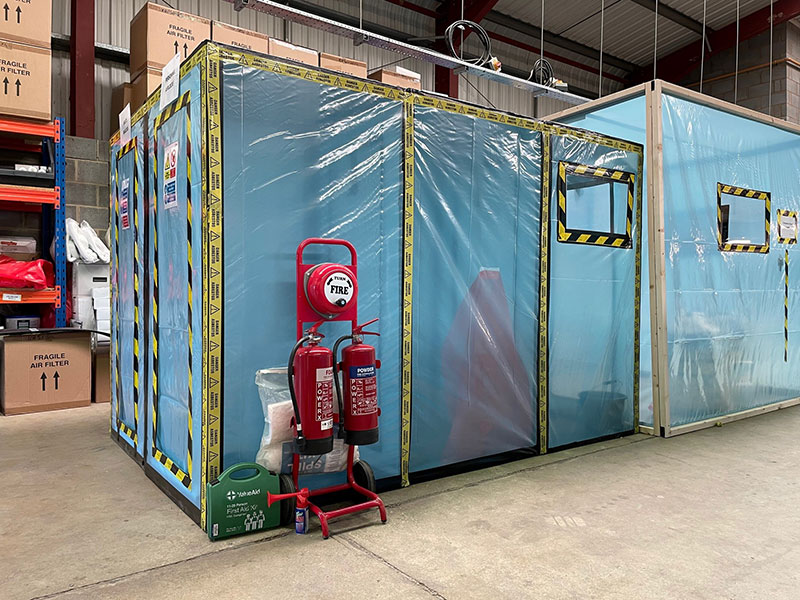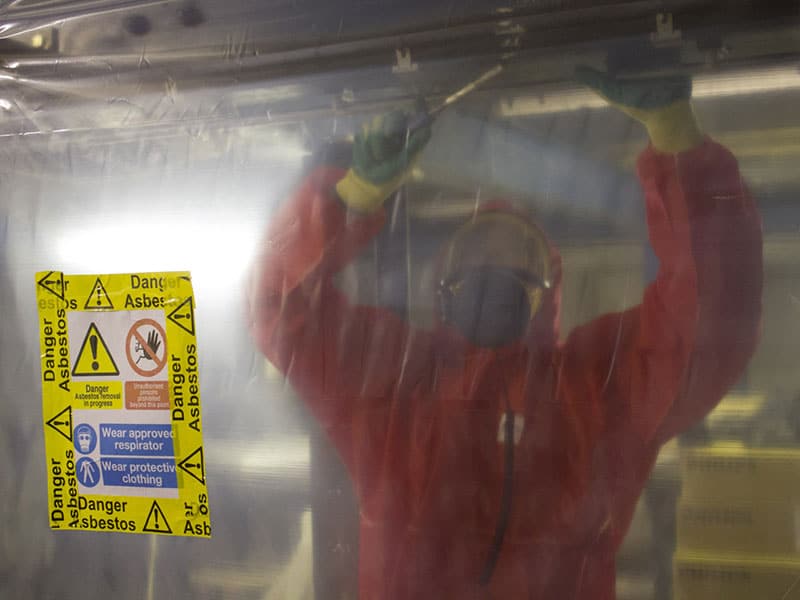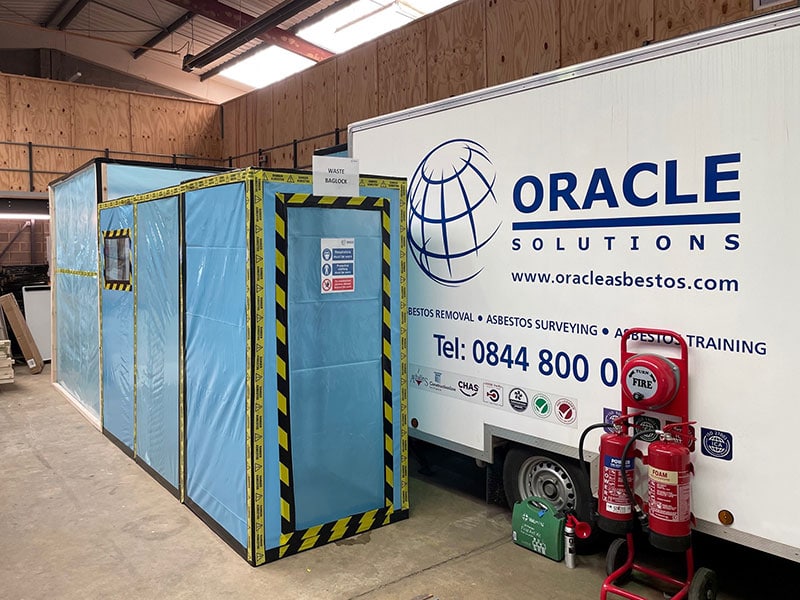What is the role of enclosures in asbestos removal work?
At sites and premises where asbestos removal work is taking place, a critically important element is the asbestos enclosure.
After all, any situation in which asbestos-containing materials (ACMs) are disturbed – as would obviously be the case if ACMs are being removed from the given site altogether – presents a risk of potentially dangerous asbestos fibres being released into the air. Such loose fibres could consequently be breathed in or swallowed by someone nearby, with all the attendant risks for the exposed individual’s long-term health.
The right enclosure, then, will serve as a crucial means of containing and controlling much of the risk that an asbestos removal operation can pose. But what else do you need to know about the definition, purpose, and benefits of asbestos enclosures, as someone who may have responsibilities for managing asbestos on a particular site under UK law?
What is an enclosure in asbestos removal work?
An asbestos enclosure can be defined as a physical barrier, employed around an area where asbestos removal work is taking place, and which is meant to contain asbestos dust and waste that may arise from the work.
This makes an enclosure a fundamental component for controlling asbestos risks. Such a structure is designed to prevent any released and floating asbestos fibres or particles in the air from spreading beyond the work site to the surrounding environment.
The role that a well-designed asbestos enclosure plays in stopping asbestos fibres from spreading, means it can also prevent such fibres from subsequently landing on and contaminating surfaces. This could otherwise be a high risk during asbestos removal operations, given the various stages involved such as the handling and bagging of waste, which could easily cause asbestos fibres to be released and linger in the air.
Asbestos enclosures are also distinguished by certain important design features. Among these are the entrance and exit openings, known as “airlocks”, that allow for the controlled movement of personnel, waste, and equipment in and out of the enclosure.
A typical asbestos enclosure also comprises such elements as viewing panels and a negative pressure unit, or NPU, which we will elaborate on shortly.
Why are enclosures necessary for asbestos removal?
Part of the reason why enclosures are so important for asbestos removal situations, is simply the extremely serious health risks that could otherwise be posed if such enclosures were to be absent.
After all, even to this day, approximately 5,000 deaths a year in the UK can be attributed to asbestos-related diseases such as mesothelioma and asbestos-related lung cancer. The long latency period that applies to such conditions means that many deaths occurring now will be due to incidents of asbestos exposure predating the 1999 ban on all forms of asbestos in the UK. However, It is also true that new instances of asbestos exposure can and do happen.
The erection of a suitable asbestos enclosure, then, prior to an asbestos removal job for which it is a requirement, can help lower the risk of anyone nearby coming into direct contact with asbestos while the work is being done.
Indeed, in the UK of the 2020s, there are also stringent health and safety regulations and guidelines, which mandate the use of enclosures in certain asbestos removal scenarios.
For example, Regulation 16 of the Control of Asbestos Regulations 2012 (CAR 2012) – which is the overarching asbestos legislation for the UK – sets out that employers have a duty to prevent or reduce the spread of asbestos in any location where work is being carried out under their control. Enclosures can greatly contribute to the fulfilment of this duty, by minimising the risk of asbestos fibres spreading beyond the main work location to the wider environment.
As a general rule, most licensable work with asbestos is likely to necessitate the use of a full enclosure, unless this is not reasonably practicable. It is not usually necessary for an enclosure to be used for work with non-licensed asbestos products, such as cement materials.
How are enclosures constructed for asbestos removal projects?
There are various steps involved in the construction process for an asbestos removal enclosure. It can be expected that the essential stages will include:
- Preparation of the given site for construction of the enclosure. A pre-work visual site inspection should be performed, to determine whether the area to be enclosed – as well as the immediate surrounding areas – will require pre-cleaning.
- Construction of the enclosure in earnest. The exact measures here will depend on such factors as the extent to which any existing building structure is used, as well as the duration of the job and the location of the work.
- Incorporation of the air extraction equipment. Mechanical extract ventilation needs to be applied to maintain the air pressure inside the enclosure slightly below atmospheric pressure (known as negative pressure). This ensures that the airflow through any leaks in the enclosure will be inwards instead of outwards, thereby making sure asbestos dust is contained inside the enclosure.
Earlier, we referenced the negative pressure unit, or NPU. This unit – also sometimes referred to as simply the “air extraction unit” – needs to be thought about carefully, to ensure that effective airflow management is achieved through the enclosure and airlocks. Normally, the NPU should be situated outside of the enclosure, with only the pre-filter visible from the inside.
Prior to asbestos work commencing inside the enclosure, a thorough visual inspection will be needed. This will help to ascertain that the enclosure has been built correctly and has been effectively sealed.
What types of asbestos work require an enclosure?
It is typically work on the most hazardous ACMs – such as asbestos insulation, asbestos coatings, and asbestos insulating board (AIB) – in other words, those for which a licence is required from the HSE – that will also require an enclosure.
Examples of such ACMs encompass asbestos boiler and pipe insulation, as well as sprayed asbestos applied for the purposes of fire protection, anti-condensation, and acoustic control. Meanwhile, the AIB products that may be worked on – and for which an enclosure will be required – include the likes of ceiling tiles and panels, and boards containing asbestos.
It will also be necessary to set up an asbestos enclosure in a situation where, although the work may have primary controls such as glove bags, the consequences of a control failure would be significant with regard to contamination and risk – thereby necessitating secondary containment.
As a general rule, an enclosure will not be needed for work with non-licensed asbestos products. Examples of these include cement materials such as corrugated roofing sheets and building panels.
What are the key features of an effective asbestos removal enclosure?
An effective asbestos enclosure will typically comprise such features as the main enclosure itself, as well as an airlock, viewing panels, and the NPU.
Beyond this, a wide range of factors will need to be considered in the design and construction of a given asbestos enclosure. These will range from the size of the enclosure, means of access, and ensuring the enclosure is effectively sealed and as airtight as possible, right through to extraction (negative pressure), decontamination units, and signage.
Further in-depth information on the key features of an effective asbestos enclosure can be found in the HSE’s free-to-download Asbestos: The licensed contractors’ guide (HSG247).
It will also be necessary for regular inspections and integrity checks to be carried out, to ensure the enclosure continues to be secure throughout the asbestos removal process. Again, this requirement is covered in further detail in the HSG247 publication.
What training is required to work with asbestos enclosures?
Regulation 10 of CAR 2012 requires every employer to make sure that adequate information, instruction, and training is given to their employees who are or who are liable to be exposed to asbestos, or who supervise such employees.
The need for an enclosure to be used tends to correspond with the need to carry out especially high-risk asbestos work – which, in turn, tends to be work that requires a licence from the HSE.
So, you should familiarise yourself with the training requirements for licensed asbestos removal work. As we have previously written about here at Oracle Solutions, asbestos licensed training, also known as “category C” training, covers such vital subjects as the construction of work enclosures, the broader setup of a work area, and decontamination procedures within airlocks, enclosures, and decontamination units.
How are enclosures dismantled safely after asbestos removal?
Once asbestos removal work within the enclosure has been completed, the structure will need to be safely and systematically dismantled. A crucial part of this process will be final decontamination and clearance testing, to ensure no residual asbestos fibres remain.
The enclosure will need to be cleaned, inspected, and tested in accordance with the four-stage clearance procedures set out by CAR 2012. Those four stages are (1) the actual asbestos removal, (2) an initial inspection, (3) air monitoring and testing, and (4) final assessment and certification.
As long as the clearance air test brings a satisfactory result, careful dismantling of the enclosure can begin after this. The aforementioned stage four of the clearance process can then be carried out once the enclosure has been dismantled. This should entail visual inspection of the site of the work area, aimed at ensuring no asbestos waste or debris was hidden by the enclosure or released during the dismantling.
Exposure to asbestos fibres can still happen even while dismantling is taking place – for example, as a consequence of fibres being released from the surface of polythene sheets. So, it is of the utmost importance that suitable personal protective equipment (PPE) is worn, and safe systems of work complied with.
Conclusion: enclosures as a cornerstone of safe asbestos removal
In this article, we have sought to make clear how vitally important asbestos enclosures can be for ensuring the safety of asbestos removal work. When regulatory requirements and best practices are followed in relation to the construction and use of enclosures for asbestos removal projects, this can greatly help to protect both workers and the environment.
Are you in need of a fast and free quote for any of our broad range of nationally renowned, accredited, and licensed asbestos services at Oracle Solutions? If so, please do not hesitate to reach out to us via phone or email.

Written by Callum McDonald
Callum McDonald is an expert in asbestos quality management, ensuring rigorous adherence to regulations and high-quality standards in removal projects. His focus on enhancing quality and client satisfaction makes him a crucial asset in safety and compliance within the field. Callum's expertise in technical support and oversight of licensed works underscores his commitment to excellence in asbestos management, providing invaluable guidance to clients in this specialised area.



